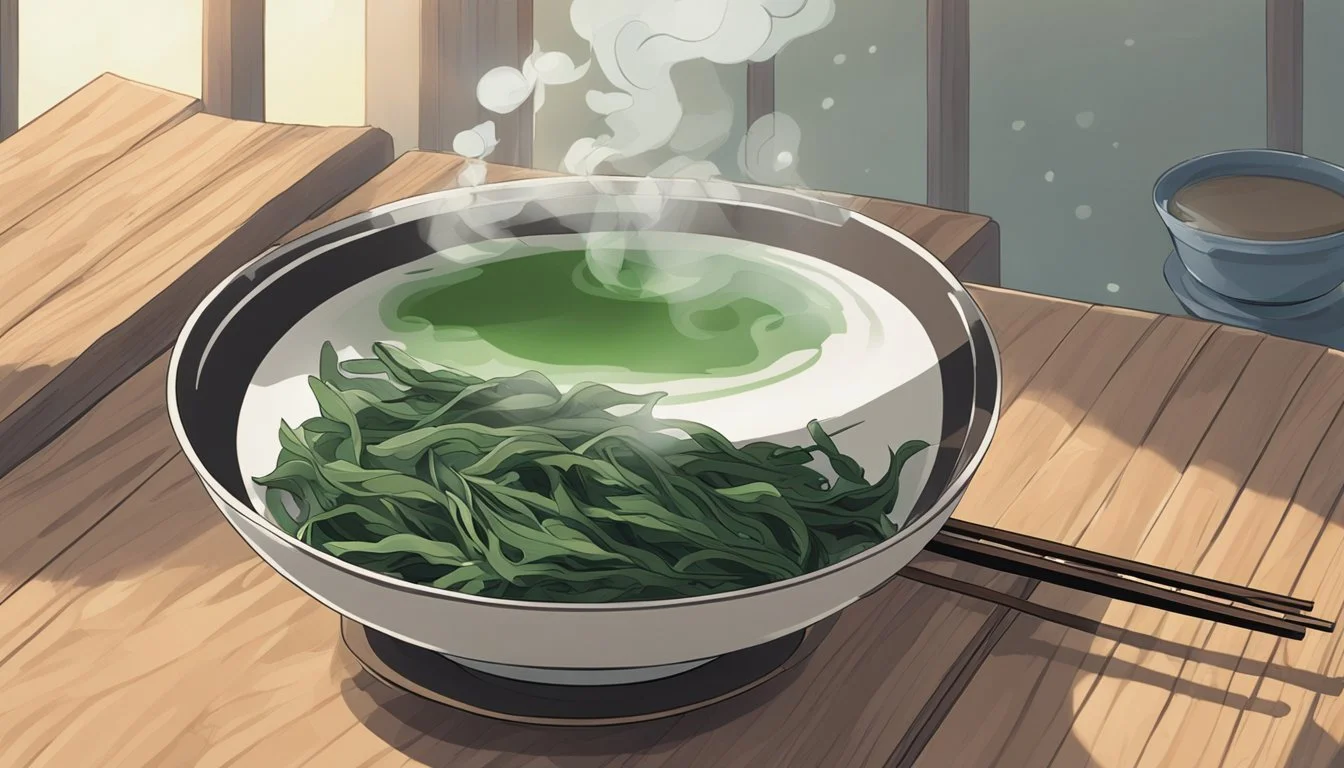How do you eat wakame?
A Guide to Enjoying this Nutritious Seaweed
Wakame, a sea vegetable known for its tender yet distinct texture, is a type of edible seaweed that has found a place in various culinary traditions, notably those of Japan and Korea. It boasts a subtle, sweet flavor and a slippery, silky quality, which makes it an agreeable addition to a wide range of dishes. This seaweed can be purchased fresh, dried, or salted, and is most commonly rehydrated before use, returning to its original supple state once soaked in water.
In the culinary world, wakame is celebrated for its versatility and health benefits. It is a nutritional powerhouse, packed with vitamins A, C, E, and K and valuable minerals like iodine, iron, copper, and phosphorus. Its uses in the kitchen are diverse. Wakame can be incorporated into soups, where it softens beautifully, adding nutrients and texture. It is a staple in the Japanese miso soup and can also be served cold in salads (What wine goes well with salads?) , delivering a satisfying crunch.
Moreover, wakame is not limited to traditional Asian dishes; it finds its way into contemporary recipes as well. Vegetarians and vegans, for instance, use wakame to add a depth of flavor to plant-based dishes, with its umami qualities enhancing dips, spreads, and even as a dynamic addition to smoothies. Whether used as a complement to a dish or as the main ingredient, wakame serves as a culinary bridge between the sea and the table, lending its unique qualities to each plate it graces.
Nutritional Profile of Wakame
Wakame, a type of edible seaweed, is notably nourishing, featuring a broad spectrum of vitamins and minerals, along with protein and fatty acids. Its composition makes it a beneficial addition to a balanced diet.
Vitamins and Minerals
Wakame is an exceptional source of iodine, essential for thyroid function. It contains a rich blend of minerals, including manganese, magnesium, and calcium, which play key roles in bone health, enzyme functions, and maintaining heart rhythm. The seaweed also provides vitamins such as vitamin A, C, E, and K, contributing to immune health, vision, and blood clotting. Notably, wakame is also a source of folate, important for DNA synthesis and repair, and iron, crucial for oxygen transport in the blood.
Calcium: Supports bone structure and health
Magnesium: Aids in many biochemical reactions in the body
Iron: Vital for blood production and energy
Manganese: Contributes to the metabolism of amino acids, cholesterol, glucose, and carbohydrates
Protein and Fatty Acids
Wakame contains a modest amount of protein, contributing to muscle maintenance and overall health. Additionally, it has a favorable profile of fatty acids, including omega-3 fatty acids, which are important for cardiovascular health and reducing inflammation.
Protein: Essential for building and repairing tissues
Omega-3 fatty acids: Support heart health and anti-inflammatory processes
With these nutrients, wakame is a potent seaweed that offers various health benefits when incorporated into the diet.
Health Benefits Associated with Wakame
Wakame, a nutrient-packed seaweed, is celebrated for its potential in assisting with weight management, supporting heart and blood health, regulating thyroid function, and aiding in cancer prevention. These benefits stem from its rich composition of vitamins, minerals, and bioactive compounds.
Weight Management
In the realm of weight management, wakame contains fucoxanthin, a compound that promotes fat oxidation and may aid in fat burning. This is crucial in tackling obesity, as it helps to enhance the metabolism. Furthermore, the low-calorie and high-nutrient profile of wakame supports a healthy diet for those looking to maintain or lose weight.
Heart and Blood Health
Wakame may benefit heart and blood health by contributing to the reduction of blood pressure and cholesterol, two key risk factors for heart disease. The presence of omega-3 fatty acids in wakame is particularly important, as these fats are known to decrease inflammation and help prevent chronic diseases including diabetes.
Thyroid Function
The thyroid gland requires iodine to produce essential thyroid hormones, and wakame is an excellent source of this micronutrient. Adequate iodine intake is crucial to avoid iodine deficiency disorders and ensure proper thyroid function, which in turn helps regulate metabolism and energy levels.
Cancer Prevention
Compounds found in wakame, such as fucoxanthin and other polyphenols, may offer protective effects against the development of cancer. These substances act as antioxidants and anti-inflammatory agents, potentially reducing the risk of cancer cell formation and growth. However, one must note that consumption of wakame should be balanced with awareness of marine pollutants that can accumulate in seaweeds.
Selecting and Storing Wakame
When choosing wakame, the format—fresh or dried—will influence the flavor and texture of your dishes, while proper storage is essential for maintaining its quality.
Fresh vs. Dried Wakame
Fresh Wakame: Typically found in Asian markets, fresh wakame should appear vibrant and have a subtle sea scent. Its texture is softer than dried, making it suitable for salads and cold dishes.
Dried Wakame: More commonly available, especially online, dried wakame is a concentrated form that requires rehydration. One should look for packaging free from moisture and any signs of discoloration.
Storage Tips
Dried Wakame: Store in a cool, dark place in an airtight container to protect it from moisture and extend its shelf life. Refrigeration is recommended for long-term storage, ensuring it remains dry and free from foreign odors.
Rehydrated Wakame: Once rehydrated, it should be used immediately or stored in the refrigerator for a maximum of a few days, in a container with a tight-fitting lid to prevent it from absorbing other flavors.
By following these guidelines, consumers can enjoy the health benefits and culinary versatility of wakame, whether incorporating it into a brothy soup or a refreshing salad.
Preparing Wakame for Consumption
Wakame is a nutritious and versatile seaweed often used in Japanese cuisine. Preparation typically begins with rehydration, and proper handling ensures the wakame retains its texture and flavor.
Rehydrating Dried Wakame
Dried wakame requires reconstitution before it is suitable for eating. To rehydrate, the following steps are recommended:
Measure: Take the desired amount of dried wakame. Keep in mind that it will expand significantly upon rehydration.
Soak: Place the wakame in a bowl of warm water.
Wait: Let the seaweed sit for approximately 5 to 10 minutes. Check for a soft, supple texture to know it's fully reconstituted.
Drain: Remove the wakame from the water and gently squeeze out any excess liquid.
With this process, the wakame is reconstituted and ready for further culinary uses, such as incorporating into salads or soups.
Handling and Cleaning
Once wakame is rehydrated, handling and cleaning are important to ensure it is ready to be eaten.
Inspect: Look for any foreign materials or overly hard parts that didn't rehydrate properly and remove them.
Rinse: Give the rehydrated wakame a gentle rinse under cold water to remove any residual salt or impurities.
Cut: Using a knife, trim the wakame to the desired size for your recipe. It often comes in long strands, so cutting it to bite-sized pieces is common.
Proper handling not only improves the visual appeal of the seaweed but also its texture and palatability when consumed.
Incorporating Wakame into Meals
Wakame, a nutritious seaweed with a slight sweetness, can be effortlessly integrated into various dishes, enhancing meals with its unique texture and flavor profile.
Salads and Side Dishes
Wakame seaweed is a staple in Japanese seaweed salad, where it's praised for its pleasing texture and ability to absorb flavors. To prepare a cucumber and wakame salad, mix thin slices of cucumber with rehydrated wakame, and dress with a mixture of soy sauce, vinegar, sesame oil, and a hint of sugar. Wakame also complements other salads and can be tossed into a side dish with sesame seeds and light Asian dressing.
Soups and Main Courses
Incorporating wakame into soups and main courses is simple and enriches dishes with its marine essence. A prime example is miso soup, a Japanese classic, where wakame is added to the broth alongside tofu and green onions. Wakame can also be included in vegetable soups or used as a garnish for seafood-based entrées. It is versatile enough to be a part of sushi (What wine goes well with sushi?) rolls or served alongside rice to bring a touch of the ocean to the plate.
Snacks and Garnishes
Wakame makes for an intriguing addition to various snacks. An innovative use is creating a fine chop of rehydrated wakame mixed with seasonings to form a unique and flavorful garnish. Sprinkle over dishes such as battered tofu or crackers to add a nutritional boost and a briny crunch.
Flavor Pairings and Seasoning
When it comes to wakame seaweed, its distinctive taste complements a variety of flavors and seasonings. From traditional Japanese pairings to innovative modern culinary uses, wakame's versatility shines through in its ability to harmonize with different ingredients.
Traditional Japanese Flavorings
The classic Japanese approach to seasoning wakame highlights its natural umami flavor. Key ingredients include:
Soy Sauce: Contributes a salty depth to wakame dishes.
Rice Vinegar: Provides a mildly tangy accent that can enhance the overall taste of wakame.
Sesame Oil: Often drizzled over wakame for an aromatic and rich nuttiness.
Sesame Seeds: Commonly sprinkled on top of wakame dishes for added texture and flavor.
Together, these seasonings create a harmonious balance and bring out the subtleties of wakame, whether served in salads, soups, or stir-fries.
Modern Culinary Uses
In modern cuisine, wakame seaweed transitions gracefully into inventive and eclectic dishes. Chefs may introduce the sweet-tangy dynamic of various dressings or dips to contrast with wakame's umami richness. Here are a few contemporary pairings:
Sweet: A dressing made with a hint of sugar or sweet syrups can complement the minerality of wakame.
Tangy: Citrus juices or vinegars in dressings can provide a fresh counterpoint to the savory notes of the seaweed.
Dips: Wakame can be a key ingredient in dips, mixed with vegan mayonnaise and mustard for a savory, tangy, and slightly sweet flavor profile.
These flavor pairings and seasoning choices are essential for creating dishes that elevate wakame beyond its traditional uses, showcasing its flexibility and appeal in various culinary contexts.
Cultural Significance
Wakame seaweed holds a revered place in various Asian cultures, especially within Japanese and broader Asian culinary traditions. It is not only a food item but also carries historical and cultural importance that traces back centuries.
Wakame in Japanese Tradition
In Japan, wakame has a deep-rooted presence signifying prosperity and health. During the Setsubun festival, which marks the start of spring in the Japanese calendar, wakame is often included in dishes as a symbol of a fresh beginning and to ward off evil spirits. The region of Hokkaido is renowned for its high-quality seaweed, widely considered a staple in the local diet, with wakame featuring prominently in Japanese cuisine. Historically, Japanese fishermen carefully harvested this seaweed, practicing sustainable collection methods that have been passed down through generations.
Wakame's Role in Asian Cuisine
In the broader context of Asian cuisine, wakame transcends Japanese traditions and is a common ingredient in Chinese and Korean dishes as well. It's primarily used in soups and salads and has become a mainstay in Asian markets across the globe. In Korea, for example, wakame is used to prepare a variety of side dishes and soups, notably miyeokguk – a soup traditionally consumed by women after childbirth for its nutritional benefits. The importance of wakame in Asian cuisine is a reflection of the region's reliance on the sea for sustenance and the ingenuity in utilizing what the ocean provides, such as various forms of seaweed including nori, kelp, and dulse.
Cooking Techniques and Recipes
Wakame, a nutritional sea vegetable, serves as an ingredient in a variety of dishes ranging from simple salads to complex culinary creations. Known for its health benefits, it can enhance meals both in flavor and nutritional value.
Simple Wakame Salad
For a basic Wakame Salad, one starts by rehydrating dried wakame and then mixes it with ingredients such as cucumbers, rice vinegar, soy sauce, sesame oil, and sesame seeds. This combination yields a refreshing, crunchy salad with the unique umami flavor that wakame is celebrated for.
Ingredients:
Rehydrated wakame
Sliced cucumbers
Rice vinegar
Soy sauce
Sesame oil
Sesame seeds
Begin by soaking the wakame in warm water until it expands and softens.
Thinly slice the cucumbers and combine with the drained wakame.
Prepare a dressing of rice vinegar, soy sauce, and sesame oil.
Toss the salad with the dressing and sprinkle with sesame seeds before serving.
Complex Dishes with Wakame
In more Complex Dishes with Wakame, chefs often incorporate this sea vegetable into easily prepared wakame brown rice for added nutrition, create various seaweed salads with multiple types of sea vegetables, or wrap the wakame in sushi rolls. Wakame's versatility also extends to soups, where it acts as a succulent texture, and to hearty dishes paired with robust vegetables.
Examples of complex dishes:
Wakame Brown Rice
Seaweed Salads
Sushi Rolls with Wakame
Miso Soup with Wakame
Wakame with Braised Vegetables (What wine goes well with braised vegetables?)
In preparing wakame brown rice, one might include wakame as part of the cooking liquid for the rice or mix it through the cooked rice (how long does cooked rice last?) for textural contrast and flavor. For a heartier option, braising wakame with root vegetables can accentuate autumnal dishes, providing a balance of earthy and oceanic tastes.
Considerations and Side Effects
When adding wakame seaweed to the diet, individuals should be mindful of several considerations and potential side effects.
Iodine Content: Wakame is rich in iodine, a mineral essential for thyroid function. However, excessive iodine intake can lead to thyroid imbalances such as hypothyroidism or hyperthyroidism, particularly in individuals with pre-existing thyroid conditions. Moderation is key.
Allergies: As with any food, there is a risk of allergies. Those with known seaweed or iodine sensitivities should avoid wakame.
Minerals and Nutrients: While wakame provides a spectrum of minerals and nutrients beneficial for health, it is also high in sodium, which may affect those with high blood pressure. Individuals should monitor intake to avoid exacerbating hypertension.
Blood Sugar: Some studies suggest that wakame can improve glucose metabolism, making it potentially beneficial for managing blood sugar levels. It could be supportive for individuals with insulin resistance, but dietary changes should always be discussed with a healthcare provider.
Recommended Intake: There is no established guideline for the right amount of wakame to consume. Individuals should consider their overall dietary intake of iodine and sodium to determine appropriate portions of wakame in their diet.
In summary, while wakame is nutritious, it is important to consume it in moderation, considering individual health needs, especially regarding iodine and sodium intake. Those with thyroid conditions or allergies should consult a healthcare provider before adding wakame to their diet.
Environmental Impact and Sustainability
Sustainable agriculture practices are crucial in the modern world, and seaweed farming, particularly wakame or sea mustard, plays a pivotal role in these efforts. Wakame, as an edible seaweed, is not only a nutritious sea vegetable but also carries a low environmental footprint when harvested responsibly.
The cultivation of wakame is typically done without the use of fertilizers or pesticides, which can be detrimental to marine ecosystems. Instead, it requires only the sea itself and something to attach to, like ropes or nets, which may sometimes be made of materials like rubber. This simplicity in the farming process reduces the input of harmful substances into the ocean, maintaining water quality and supporting marine biodiversity.
Moreover, wakame cultivation can positively impact the environment by:
Absorbing Carbon: Seaweed farms act as carbon sinks, absorbing CO2 from the atmosphere and helping to mitigate climate change.
Improving Water Quality: By absorbing excess nutrients in the water, wakame can prevent harmful algal blooms that lead to dead zones.
Providing Habitat: Seaweed farms offer a structure for marine organisms to inhabit, similar to underwater forests.
The sustainability of wakame is also evident in its ability to grow rapidly without the need for fresh water or land, making it a highly renewable resource. Harvested correctly, wakame production has the potential to provide a continuous supply of this nutritious sea vegetable while having a minimal adverse impact on the environment.
Nutritional Research and Studies
Wakame, a type of edible seaweed, has been studied for its nutritional content and potential health benefits. One study identified wakame as a rich source of essential nutrients including iodine, minerals, and vitamins such as Vitamin C. In particular, iodine plays a critical role in thyroid health, influencing hormone production.
Iodine: Vital for thyroid function and hormonal balance
Minerals: Includes iron, copper, and phosphorus
Vitamin C: An antioxidant supporting immune health
Researchers have also investigated the unique compounds in wakame, such as fucoxanthin. This compound is noted for its potential in influencing metabolism and fat storage. Furthermore, wakame contains omega-3 fatty acids, which are important for heart health and have been linked to lowering LDL (bad) cholesterol levels.
Fucoxanthin's Role:
Metabolic influence
Fat storage regulation
Omega-3 Fatty Acids Benefits:
Heart health support
LDL cholesterol reduction
In relation to cancer research, components within wakame have been studied for their possible protective effects against breast cancer. Its richness in certain nutrients and its hypothesized antitumor activities warrant further investigation to fully understand these interactions.
Wakame's Cancer Research Focus:
Antitumor activities
Breast cancer protective effects
This wealth of nutrients and the ongoing studies surrounding wakame highlight its potential role in a balanced diet and its possible contributions to disease prevention. Such research continues to build a confident understanding of how wakame can support overall health when incorporated into a diverse diet.






